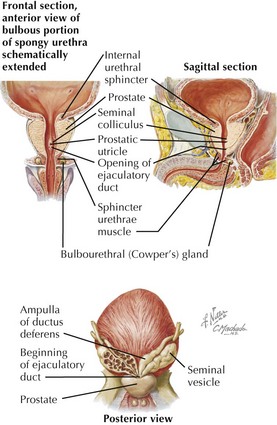18 Prostate Diseases
Basic Anatomy
Prostate Proper
• Glandular growth and maturation controlled by testosterone, which is converted to dihydrotestosterone (DHT) by 5-alpha reductase
• Middle lobe: most common site of benign prostatic hyperplasia (BPH), process arising in the periurethral transitional zone
• Anatomical parts: base, apex, four surfaces
 Anterior surface: retropubic, with largely transverse musculature, forms a rhabdosphincter (hemisphincter)
Anterior surface: retropubic, with largely transverse musculature, forms a rhabdosphincter (hemisphincter)
 Anterior surface: retropubic, with largely transverse musculature, forms a rhabdosphincter (hemisphincter)
Anterior surface: retropubic, with largely transverse musculature, forms a rhabdosphincter (hemisphincter)• Supported anteriorly by puboprostatic ligaments, central portions of the pubococcygeus, part of the levator ani muscles (anterior pelvic diaphragm)
• Supported inferiorly by the urogenital diaphragm (transversus perinei muscle and fascia), through which the urethra passes
Prostatic Capsule(s)
• Prostatic (true) capsule: thin, dense, fibrous connective tissue enclosing parenchyma and surrounded by—
Prostatic Ducts and Urethra
• Seminal colliculus (verumontanum) in posterior urethral wall marks location of paired ejaculatory ducts draining ductus deferens and seminal vesicles.
Stay updated, free articles. Join our Telegram channel

Full access? Get Clinical Tree















